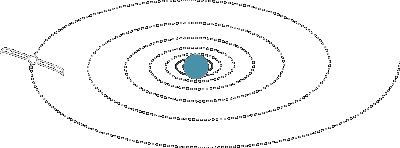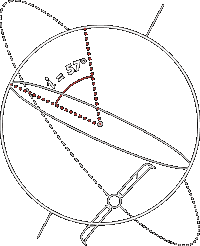
Brief technical explanations
KEO is a small passive satellite all set to embark on a 50,000 year odyssey. To maximize the success of its mission, today's leading edge technology has been harnessed.
 Passive satellite
Passive satellite
Passive signifies that it has no energy, no instrumentation, no electronics aboard.
Once in orbit, KEO will rely entirely on the forces of nature to return to its native soil.
These forces include:
- laws of ballistics,
- planetary and lunar attraction,
- pressure of solar radiation,
- and friction due to the dense atmospheric layers.
 Orbit preferred
Orbit preferred
The orbit desired for KEO is a circular orbit with an inclination of less than 57° and an altitude of 1,800 km. Keeping in mind the duration of its mission, 50,000 years, this orbit is a compromise between the current launch possibilities and the capacity of its structure to sustain cosmic radiation and resist micrometeorite and debris impacts.
Secondary passenger on launch vehicle
KEO'S core body is a sphere with a diameter of about 0.8 meters, with a total wingspan of approximately 10 meters, weighing less than 100 kgs.
Due to its light volume and small mass, KEO can fly as a secondary passenger on a launch vehicle heading towards the appropriate orbit.
 KEO'S Protective shields
KEO'S Protective shields
Space is a very aggressive environment. In order to keep its liveload intact, KEO will be cushioned by several protective shields:
- anti-atomic oxygen shield, composed of an aluminum layer, to limit oxidation,
- anti-cosmic ray shield, composed of successive layers of titanium and tungsten to reinforce the natural protection provided by the Van Allen belts,
- anti-meteorite and anti-debris shield, several layers of heavy materials are intertwined with vacuum,
- thermal shield capable of resisting up to 2800°C and responsible for the artificial Aurora Borealis that will be created during KEO'S return to Earth.

 Wings animated by shape memory alloys
Wings animated by shape memory alloys
Once in orbit, KEO'S wings will take life, fluttering in rhythm to its passage under the Earth's shadow and the sun's ray, similar to that of a beautiful migratory bird gliding across the horizon.
To enable its wings to beat, KEO uses a leading-edge technology: shape memory alloys.
These are metallic alloys which "learn" to assume different shapes according to different temperature ranges and revert to these shapes each time they are put back under the same temperatures. Here, we are exploiting the difference in temperature between shadow and sunlight, so that during its journey around the Earth, KEO will naturally spread its wings when it is touched by the sun's rays and fold them when it re-enters the Earth's shadow.
 Artificial Aurora Borealis
Artificial Aurora Borealis
A few moments before landing, due to the heating effect as it glides across the numerous layers of atmosphere, KEO'S specially prepared thermal shield will trigger off an ionization phenomenon, creating a shower of luminous lights, resembling the Northern Lights.
Landing
The archeological gifts carried by KEO are protected by an internal anti-shock shield made of metallic sponge encased in a titanium shell. This shield can resist an impact speed at re-entry of a maximum of 103.3 m/s., comparable with today's re-entry vehicle performances.
The density of the returning shell has been calculated to be inferior to 1 so as to ensure buoyancy in case of sea landing.
For further information, you can download a 3-page Wordİ document (English version) on KEO'S technical feasibility, an extract from a paper, presented by Aerospatiale at the 48th International Astronautical Congress, Turin, October 1997
